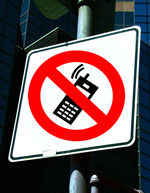Cell phone ban in for commercial insurance drivers.
 On January 3, 2012, a new US Department of Transportation (US DOT) rule prohibiting interstate truck and bus drivers from using hand-held cell phones while operating their vehicles goes into effect. Businesses and individuals who operate commercial vehicles need to be fully aware of this law and its implications. There are strict penalties for both drivers and businesses found to be in violation of the rule.
On January 3, 2012, a new US Department of Transportation (US DOT) rule prohibiting interstate truck and bus drivers from using hand-held cell phones while operating their vehicles goes into effect. Businesses and individuals who operate commercial vehicles need to be fully aware of this law and its implications. There are strict penalties for both drivers and businesses found to be in violation of the rule.
Although the ruling specifically discusses interstate commercial vehicles, we have learned through our sources at the Massachusetts Association of Insurance Agents that the State Police Truck Team has indicated that they will enforce the hand-held phone device rule on both interstate and intrastate commercial motor vehicles. The new rule will also be enforced by Federal DOT inspections and any other state or local police officer certified to do DOT inspections.
Commercial motor vehicles fall into the following categories:
- Has a gross vehicle weight rating or gross combination weight rating, or gross vehicle weight or gross combination weight of 4.536 kg (10,001 pounds) or more, whichever is greater; or
- is designed or used to transport more than 8 passengers (including the driver) for compensation; or
- is designed or used to transport more than 15 passengers, including the driver, and is not used to transport passengers for compensation; or
- is used in transporting material found by the Secretary of Transportation to be hazardous under 49 U.S.C. 5101 and
- transported in a quantity requiring placarding under regulations prescribed by the Secretary under 49 CFR, subtitle B, chapter 1, subchapter C.
Summary of U.S. DOT rule banning use of hand-held phones by commercial vehicle drivers
No driver shall use a hand-held mobile telephone while driving a commercial motor vehicle. (49 CFR Part 392.82) A commercial motor vehicle is defined by the US DOT as a vehicle with a single or combined GVWR, or actual weight of over 10,000# utilized in interstate commerce. (Note: Most states have adopted the Federal Motor Carrier Safety Regulations for intrastate commerce with vehicles at weights ranging from 10,001 to 26,001#)
Use of a hand held mobile telephone means: (49 CFR Part 390.5)
- Using at least one hand to hold a mobile telephone to conduct a voice communication;
- Dialing or answering a mobile telephone by pressing more than a single button, or
- Reaching for a mobile telephone in a manner which requires a driver to maneuver so that he or she is no longer in a seated position.
guidance:
- This rule does not prohibit a driver from using a mounted mobile phone. which can be easily accessed from the driver’s seat and activated with a single button.
- Driving means operating a commercial vehicle while on a public road, and when stopped in traffic on such a road. Driving does not include instances when the driver is safely parked. Emergency use is permitted.
- The term mobile telephone does not include two way or Citizens Band Radio services, however the term mobile telephone does include mobile services which are provided for profit, have inter-connected service and is available to a substantial portion of the public.
penalty:
Drivers who violate the restriction will face federal civil penalties of up to $2,750 for each offense and disqualification from operating a commercial motor vehicle for multiple offenses. Driver is disqualified from operating a commercial motor vehicle (CMV) for 60 days with the second offense in 3 years. (120 days for each subsequent offense within 3 years) Only applies if violation occurred while driving a CMV. Additionally, states will suspend a driver’s commercial driver’s license (CDL) after two or more serious traffic violations. Commercial truck and bus companies that allow their drivers to use hand-held cell phones while driving will face a maximum penalty of $11,000.
additional information
For details, go to http://www.regulations.gov and search for the terms “FMCSA-2010-0096” or “PHMSA-2010-0227.” The following links may also be helpful.
